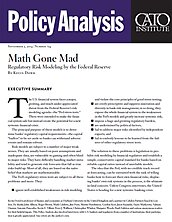The U.S. financial system faces a major, growing, and much under-appreciated threat from the Federal Reserve’s risk modeling agenda—the “Fed stress tests.” These were intended to make the financial system safe but instead create the potential for a new systemic financial crisis.
The principal purpose of these models is to determine banks’ regulatory capital requirements—the capital “buffers” to be set aside so banks can withstand adverse events and remain solvent.
Risk models are subject to a number of major weaknesses. They are usually based on poor assumptions and inadequate data, are vulnerable to gaming and often blind to major risks. They have difficulty handling market instability and tend to generate risk forecasts that fall as true risks build up. Most of all, they are based on the naïve belief that markets are mathematizable. The Fed’s regulatory stress tests are subject to all these problems and more. They:
- ignore well-established weaknesses in risk modeling and violate the core principles of good stress testing;
- are overly prescriptive and suppress innovation and diversity in bank risk management; in so doing, they expose the whole financial system to the weaknesses in the Fed’s models and greatly increase systemic risk;
- impose a huge and growing regulatory burden;
- are undermined by political factors;
- fail to address major risks identified by independent experts; and
- fail to embody lessons to be learned from the failures of other regulatory stress tests.
The solution to these problems is legislation to prohibit risk modeling by financial regulators and establish a simple, conservative capital standard for banks based on reliable capital ratios instead of unreliable models. The idea that the Fed, with no credible track record at forecasting, can be entrusted with the task of telling banks how to forecast their own financial risks, displacing banks’ own risk systems in the process, is the ultimate in fatal conceits. Unless Congress intervenes, the United States is heading for a new systemic banking crisis.

This work is licensed under a Creative Commons Attribution-NonCommercial-ShareAlike 4.0 International License.

